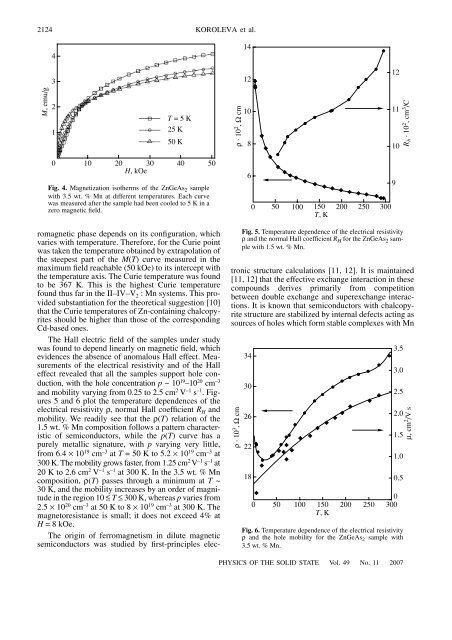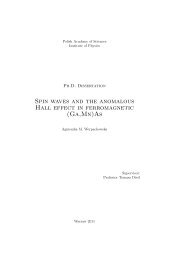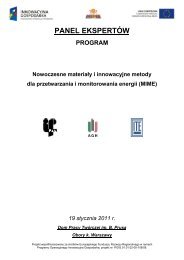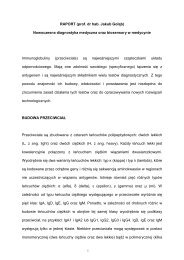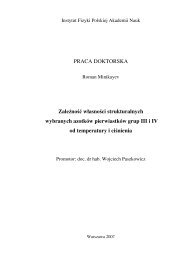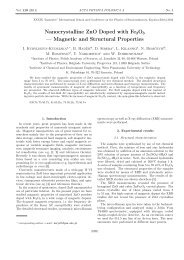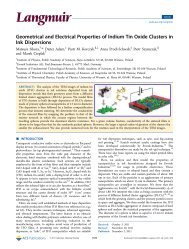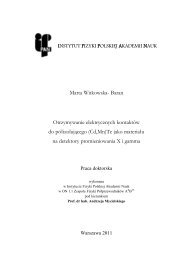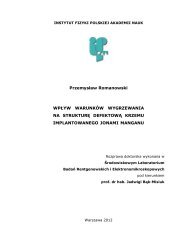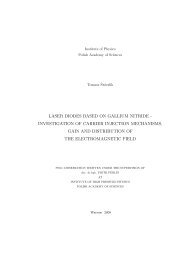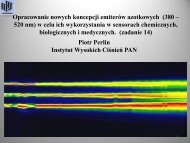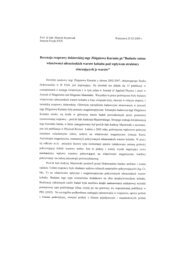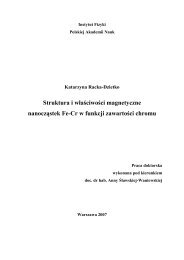Magnetic and Electrical Properties of the ZnGeAs2 : Mn Chalcopyrite
Magnetic and Electrical Properties of the ZnGeAs2 : Mn Chalcopyrite
Magnetic and Electrical Properties of the ZnGeAs2 : Mn Chalcopyrite
Create successful ePaper yourself
Turn your PDF publications into a flip-book with our unique Google optimized e-Paper software.
2124KOROLEVA et al.41431212M, emu/g21T = 5 K25 K50 Kρ · 10 2 , Ω cm1081110R h · 10 2 , cm 3 /C0 10 20 30 40 50H, kOeFig. 4. Magnetization iso<strong>the</strong>rms <strong>of</strong> <strong>the</strong> ZnGeAs 2 samplewith 3.5 wt. % <strong>Mn</strong> at different temperatures. Each curvewas measured after <strong>the</strong> sample had been cooled to 5 K in azero magnetic field.60 50 100150 200 250 300T, K9Fig. 5. Temperature dependence <strong>of</strong> <strong>the</strong> electrical resistivityρ <strong>and</strong> <strong>the</strong> normal Hall coefficient R H for <strong>the</strong> ZnGeAs 2 samplewith 1.5 wt. % <strong>Mn</strong>.romagnetic phase depends on its configuration, whichvaries with temperature. Therefore, for <strong>the</strong> Curie pointwas taken <strong>the</strong> temperature obtained by extrapolation <strong>of</strong><strong>the</strong> steepest part <strong>of</strong> <strong>the</strong> M(T) curve measured in <strong>the</strong>maximum field reachable (50 kOe) to its intercept with<strong>the</strong> temperature axis. The Curie temperature was foundto be 367 K. This is <strong>the</strong> highest Curie temperaturefound thus far in <strong>the</strong> II–IV–V 2 : <strong>Mn</strong> systems. This providedsubstantiation for <strong>the</strong> <strong>the</strong>oretical suggestion [10]that <strong>the</strong> Curie temperatures <strong>of</strong> Zn-containing chalcopyritesshould be higher than those <strong>of</strong> <strong>the</strong> correspondingCd-based ones.The Hall electric field <strong>of</strong> <strong>the</strong> samples under studywas found to depend linearly on magnetic field, whichevidences <strong>the</strong> absence <strong>of</strong> anomalous Hall effect. Measurements<strong>of</strong> <strong>the</strong> electrical resistivity <strong>and</strong> <strong>of</strong> <strong>the</strong> Halleffect revealed that all <strong>the</strong> samples support hole conduction,with <strong>the</strong> hole concentration p ~ 10 19 –10 20 cm –3<strong>and</strong> mobility varying from 0.25 to 2.5 cm 2 V –1 s –1 . Figures5 <strong>and</strong> 6 plot <strong>the</strong> temperature dependences <strong>of</strong> <strong>the</strong>electrical resistivity ρ, normal Hall coefficient R H <strong>and</strong>mobility. We readily see that <strong>the</strong> ρ(T) relation <strong>of</strong> <strong>the</strong>1.5 wt. % <strong>Mn</strong> composition follows a pattern characteristic<strong>of</strong> semiconductors, while <strong>the</strong> p(T) curve has apurely metallic signature, with p varying very little,from 6.4 × 10 19 cm –3 at T = 50 K to 5.2 × 10 19 cm –3 at300 K. The mobility grows faster, from 1.25 cm 2 V –1 s –1 at20 K to 2.6 cm 2 V –1 s –1 at 300 K. In <strong>the</strong> 3.5 wt. % <strong>Mn</strong>composition, ρ(T) passes through a minimum at T ~30 K, <strong>and</strong> <strong>the</strong> mobility increases by an order <strong>of</strong> magnitudein <strong>the</strong> region 10 ≤ T ≤ 300 K, whereas p varies from2.5 × 10 20 cm –3 at 50 K to 8 × 10 19 cm –3 at 300 K. Themagnetoresistance is small; it does not exceed 4% atH = 8 kOe.The origin <strong>of</strong> ferromagnetism in dilute magneticsemiconductors was studied by first-principles electronicstructure calculations [11, 12]. It is maintained[11, 12] that <strong>the</strong> effective exchange interaction in <strong>the</strong>secompounds derives primarily from competitionbetween double exchange <strong>and</strong> superexchange interactions.It is known that semiconductors with chalcopyritestructure are stabilized by internal defects acting assources <strong>of</strong> holes which form stable complexes with <strong>Mn</strong>ρ · 10 3 , Ω cm34302622180 50 1003.53.02.52.01.51.00.50150 200 250 300T, KFig. 6. Temperature dependence <strong>of</strong> <strong>the</strong> electrical resistivityρ <strong>and</strong> <strong>the</strong> hole mobility for <strong>the</strong> ZnGeAs 2 sample with3.5 wt. % <strong>Mn</strong>.µ, cm 2 /V sPHYSICS OF THE SOLID STATE Vol. 49 No. 11 2007


